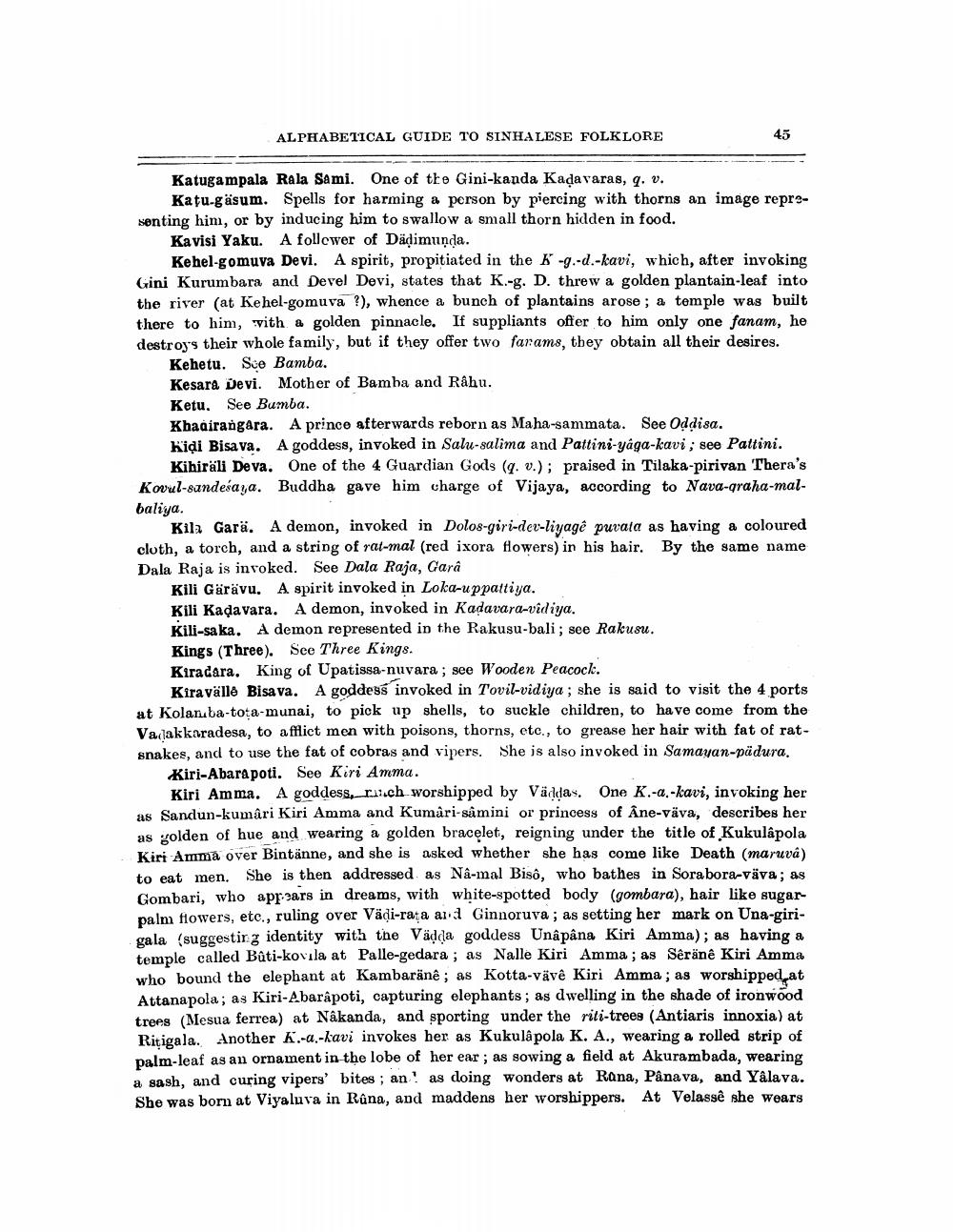________________
ALPHABETICAL GUIDE TO SINHALESE FOLKLORE
45
Katugampala Rala Sami. One of the Gini-kanda Kadavaras, q. v.
Katu-gäsum. Spells for harming a person by piercing with thorns an image representing him, or by inducing him to swallow a small thorn hidden in food.
Kavisi Yaku. A follower of Dadimunda.
Kehel-gomuva Devi. A spirit, propitiated in the K-g.-d.-kavi, which, after invoking Gini Kurumbara and Devel Devi, states that K.-g. D. threw a golden plantain-leaf into the river (at Kehel-gomuva ?), whence a bunch of plantains arose ; a temple was built there to him, with a golden pinnacle. If suppliants offer to him only one fanam, he destroy's their whole family, but if they offer two farams, they obtain all their desires.
Kehetu. Sve Bamba. Kesara Devi. Mother of Bamba and Rahu. Ketu. See Bumba. Khadirangára. A prince afterwards reborn as Maha-sammata. See Oddisa. hidi Bisava. A goddess, invoked in Salu-salima and Pattini-yaga-kavisee Pattini.
Kibirali Deva. One of the 4 Guardian Gods (q. v.); praised in Tilaka-pirivan Thera's Kovul-sandeśaya. Buddha gave him charge of Vijaya, according to Nava-graha-malbaliya
Kila Garä. A demon, invoked in Dolos-giri-der-liyagé puvala as having a coloured cloth, a torch, and a string of rat-mal (red ixora flowers) in his hair. By the same name Dala Raja is invoked. See Dala Raja, Gara
Kili Gäravu. A spirit invoked in Loka-uppattiya. Kili Kadavara. A demon, invoked in Kadavara-vidiya. Kili-sa ka. A demon represented in the Rakusu-bali; see Rakusu. Kings (Three). See Three Kings. Kiradara. King of Upatissa-nuvara; see Wooden Peacocle.
Kiravälle Bisa va. A goddess invoked in Tovil-vidiya; she is said to visit the 4 ports at Kolanıba-tota-munai, to pick up shells, to suckle children, to have come from the Va jakkaradesa, to afflict men with poisons, thorns, etc., to grease her hair with fat of ratsnakes, and to use the fat of cobras and vipers. She is also invoked in Samayan-pädura.
Kiri-Abara poti. See Kiri Amma.
Kiri Amma. A goddess, c.ch worshipped by Vädday. One K.-a.-kavi, invoking her as Sandun-kumari Kiri Amma and Kumari-samini or princess of Âne-väva, describes her as yolden of hue and wearing a golden bracelet, reigning under the title of Kukulậpola Kiri Amma over Bintänne, and she is asked whether she has come like Death (maruva) to eat men. She is then addressed as Nâ-mal Biso, who bathes in Sora bora-väva; as Gombari, who appears in dreams, with white-spotted body (gombara), hair like sugarpalm flowers, etc., ruling over Vädi-rata and Ginnoruva; as setting her mark on Una-girigala (suggestir z identity with the Vädda goddess Unâ pâna Kiri Amma); as having a Temple called Bati-kovila at Palle-gedara; as Nalle Kiri Amma; as Sêränê Kiri Amma who bound the elephant at Kambaränê; as Kotta-vävê Kiri Amma; as worshipped at Attanapola; as Kiri-Abarâpoti, capturing elephants; as dwelling in the shade of ironwood trees (Mesua ferrea) at Nâkanda, and sporting under the riti-trees (Antiaris innoxia) at Ritigala. Another 6.-9.-kavi invokes her as Kukulâ pola K. A., wearing a rolled strip of palm-leaf as an ornament in the lobe of her ear; as sowing a field at Akurambada, wearing a sash, and curing vipers' bites; an! as doing wonders at Rana, Pânava, and Yâlava. She was born at Viyaluva in Rûna, and maddens her worshippers. At Velassê she wears




